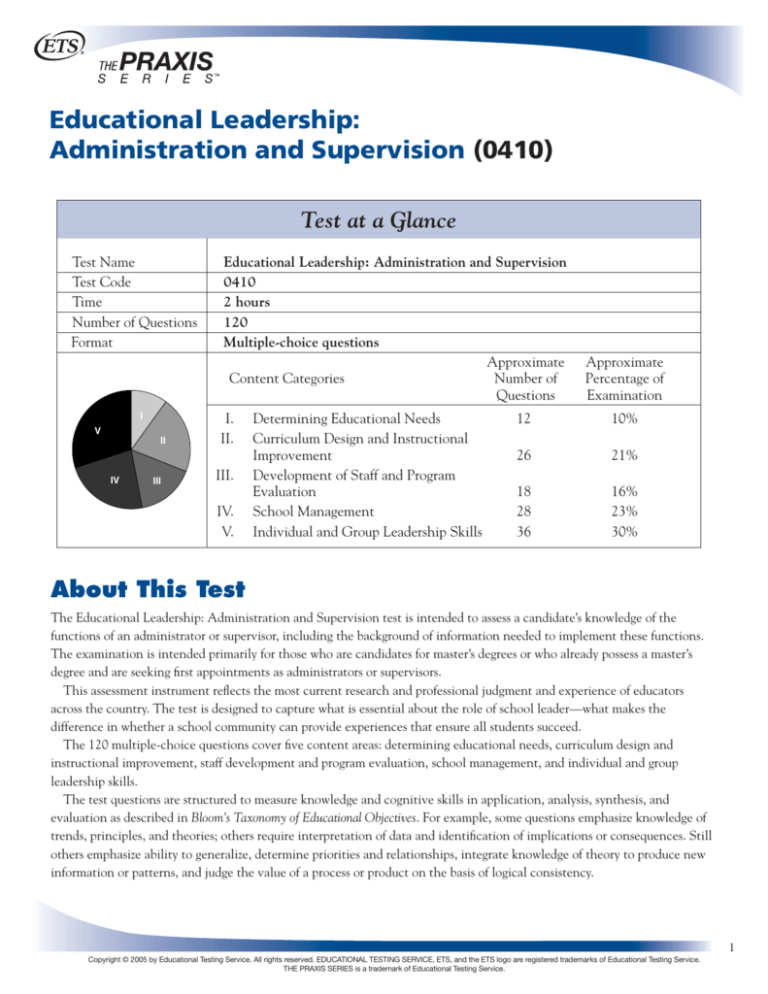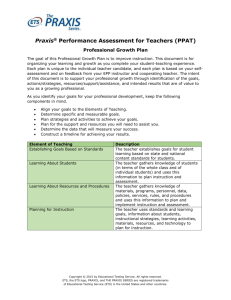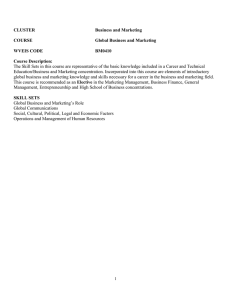
Educational Leadership:
Administration and Supervision (0410)
Test at a Glance
Test Name
Test Code
Time
Number of Questions
Format
I
V
II
IV
III
Educational Leadership: Administration and Supervision
0410
2 hours
120
Multiple-choice questions
Approximate
Content Categories
Number of
Questions
I.
II.
III.
IV.
V.
Determining Educational Needs
Curriculum Design and Instructional
Improvement
Development of Staff and Program
Evaluation
School Management
Individual and Group Leadership Skills
Approximate
Percentage of
Examination
12
10%
26
21%
18
28
36
16%
23%
30%
About This Test
The Educational Leadership: Administration and Supervision test is intended to assess a candidate’s knowledge of the
functions of an administrator or supervisor, including the background of information needed to implement these functions.
The examination is intended primarily for those who are candidates for master’s degrees or who already possess a master’s
degree and are seeking first appointments as administrators or supervisors.
This assessment instrument reflects the most current research and professional judgment and experience of educators
across the country. The test is designed to capture what is essential about the role of school leader—what makes the
difference in whether a school community can provide experiences that ensure all students succeed.
The 120 multiple-choice questions cover five content areas: determining educational needs, curriculum design and
instructional improvement, staff development and program evaluation, school management, and individual and group
leadership skills.
The test questions are structured to measure knowledge and cognitive skills in application, analysis, synthesis, and
evaluation as described in Bloom’s Taxonomy of Educational Objectives. For example, some questions emphasize knowledge of
trends, principles, and theories; others require interpretation of data and identification of implications or consequences. Still
others emphasize ability to generalize, determine priorities and relationships, integrate knowledge of theory to produce new
information or patterns, and judge the value of a process or product on the basis of logical consistency.
1
Copyright © 2005 by Educational Testing Service. All rights reserved. EDUCATIONAL TESTING SERVICE, ETS, and the ETS logo are registered trademarks of Educational Testing Service.
THE PRAXIS SERIES is a trademark of Educational Testing Service.
Educational Leadership: Administration and Supervision (0410)
Topics Covered
II. Curriculum Design and
Instructional Improvement
Representative descriptions of
● Determination of
topics covered in each category are
curriculum goals
provided below.
● Decision processes in
curriculum design
I. Determining Educational Needs
● Strategies for implementing
● Expectations concerning students
curriculum decisions
at various developmental and
● Principles of effective instruction
instructional levels
● Determination of
● Assessments of community
instructional objectives
needs, expectations, and
● Learning activities and
population projections
their relationship to
● Recognition of specific needs
instructional objectives
of diverse populations and
● Assessment of student
mobile populations, such as
achievement is utilized in
gender, race, and ethnicity
determining instructional
● Awareness of the national
strategies and priorities
perspective concerning education
● Instructional methods and
● Interpretation of research in
techniques, such as direct
making decisions
teaching, team teaching,
● Assessment of student
group instruction, contract
achievement in identifying
method, individualized
needs and setting priorities
instruction, and interdisciplinary
● Principles of developing and
instruction which promotes the
implementing strategic plans
success of all students
through use of group process
● Instructional resources and
conflict resolution and
research data related to
consensus building
curriculum needs, such as
personnel, materials, technology,
finance, business and industry,
advisory groups, community
agencies, and institutions
● Learning theories and
learning processes
● Applied motivational theories
● Involvement of stakeholders in
decision-making process
III. Development of Staff and
Program Evaluation
● Assessment of staff abilities and
determination of their needs
● Establishment of staff
development priorities
● Strategies for behavioral change
● Implementation of staff
development activities
● Indicators of achievement
relating to goals and objectives,
such as curriculum, instruction,
and learning outcomes
● Types, methods, strategies, and
procedures of evaluation
● Applications of evaluation and
research findings in the process of
goal setting and change
● Instructional staff assessment,
including conferencing,
observation, data collection, and
documentation of performance
● Staff are treated fairly, equitably,
and with dignity and respect
● Role of technology in promoting
student learning and professional
growth
● Awareness of the values of a
diverse school community and its
meaning for the educational
program
2
Copyright © 2005 by Educational Testing Service. All rights reserved. EDUCATIONAL TESTING SERVICE, ETS, and the ETS logo are registered trademarks of Educational Testing Service.
THE PRAXIS SERIES is a trademark of Educational Testing Service.
Educational Leadership: Administration and Supervision (0410)
IV. School Management
● Organizational and operational
features of school management:
– making management decisions
that enhance teaching
and learning
– theories and models of
organization and principles of
organizational development
– programs and services, such
as pupil personnel, gifted and
talented, special education,
special title and chapter,
student activities, and
ancillary services
– operational procedures at the
school and district level; line
staff relationships
– personnel selection and
evaluation procedures,
such as recruiting,
interviewing, placement,
and monitoring progress
● Governing and control features
of school management:
– educational functions of local,
state, and federal agencies and
governing bodies
– roles of various formal and
informal organizations
and agencies
– process of participatory
government, involving
students, faculty, and
the community
● Business and fiscal features of
school management:
– sources, acquisition,
and distribution of
financial resources
– utilization of support services,
such as plant operation and
maintenance, purchasing,
transportation, food services,
and support personnel
– budgeting processes
and procedures, such as
centralized, decentralized, site,
program, and zero-based
● Legal features of school
management:
– personnel negotiations/
collective bargaining
procedures
– due process procedures for
students and staff
– judicial and legislative
provisions for students with
disabilities, privacy act,
affirmative action, sex
discrimination, freedom of
information, and civil rights
– principles and issues related to
school safety and security
V. Individual and Group Leadership
Skills
● Understanding individual
behavior: basic motivations of
students, staff, and community,
as well as divergent behaviors of
students, staff, and community
● Understanding and affecting
group dynamics: analysis of
individual behavior within a
group and the ways of changing
role behavior to maximize
group productivity
● School-community relations:
recognition and consideration
of diverse values, using
community resources in
the educational process
● Communications skills:
development of effective
communications systems;
sensitivity to verbal and
nonverbal communication;
writing clearly, effectively, and
with sensitivity
● Creating and maintaining a
positive affective environment,
such as existing school cultures’
communication flow, and
informal leadership
● Problem-solving skills
3
Copyright © 2005 by Educational Testing Service. All rights reserved. EDUCATIONAL TESTING SERVICE, ETS, and the ETS logo are registered trademarks of Educational Testing Service.
THE PRAXIS SERIES is a trademark of Educational Testing Service.
Educational Leadership: Administration and Supervision (0410)
Sample Test Questions
The sample questions that follow illustrate the types of questions
in the test. They are not, however, representative of the entire
scope of the test in either content or difficulty. Answers with
explanations follow the questions.
Directions: Each of the questions or incomplete statements
below is followed by five suggested answers or completions.
Select the one that is best in each case.
1. Recommended practice suggests that which of the
following should be involved in the decision-making
process concerning curriculum?
I.
II.
III.
IV.
Curriculum experts
Boards of education
Professional staff
Parents and students
(A)
(B)
(C)
(D)
(E)
I and III only
II and III only
III and IV only
II, III, and IV only
I, II, III, and IV
2. Which of the following is the most crucial question
to consider in using community resources in
the classroom?
(A) Can the resources be used by several groups at
the same time?
(B) Have such resources been overused?
(C) Do the resources meet the needs of the program?
(D) Would the use of these resources be
controversial?
(E) What time limits have been established for the
use of the resources?
3. The role of a school psychologist would ordinarily
NOT include which of the following?
(A) Assisting teachers and administrators to develop
greater understanding of the needs and behaviors
of students
(B) Determining by observation and assessment the
procedures that best help students to learn
(C) Assisting faculty in developing procedures for
referring students to the school psychologist
(D) Assisting teachers by giving demonstration
lessons to troublesome groups of students
(E) Consulting with faculty and administrators
on ways to improve learning conditions in
the school
4. The leader can be most confident that a group is
functioning well when
(A) most participants are enjoying the task
(B) interpersonal and organizational conflicts do
not occur
(C) the reward system is more than adequate
(D) the participants are interacting with each other
on an open basis
(E) the leader and the participants are friendly
toward each other
5. Of the following, the best argument for the inclusion
of students in special education programs in activities
with general education students is the probability that
the special education students will
(A) have less need for specialized services in the
school they attend
(B) learn more in the cognitive and
psychomotor domains
(C) become more competitive with their peers
(D) receive more individualized attention for the
special nature of their disabling condition
(E) be provided with the least restrictive
environment
4
Copyright © 2005 by Educational Testing Service. All rights reserved. EDUCATIONAL TESTING SERVICE, ETS, and the ETS logo are registered trademarks of Educational Testing Service.
THE PRAXIS SERIES is a trademark of Educational Testing Service.
Educational Leadership: Administration and Supervision (0410)
6. The teaching techniques or methods that are
generally considered to have the most direct impact
on affective feelings are
(A)
(B)
(C)
(D)
(E)
discussion and dialogue
recitation and independent study
role playing and simulation
questioning and observation
lecturing and demonstration
7. A group of teachers cooperatively plan the best
learning situation for a particular student, discuss the
plan with the student, and have the student sign the
written plan. Which of the following best describes
this process?
(A)
(B)
(C)
(D)
(E)
Individualizing unit teaching
The contract method
Unit teaching with group instruction
Programmed instruction
Team teaching, individualized instruction with
the contract method
8. The United States Supreme Court has justified the
use of public tax money to support the transportation
of parochial school children on the basis of the
(A)
(B)
(C)
(D)
(E)
child benefit theory
Fourteenth Amendment of the Constitution
First Amendment of the Constitution
right to due process of law
right of parents to determine the education of
their own children
9. PL 100-297 School Improvement Act (HawkinsStafford ESEA Amendments) was primarily
designed to
(A) improve local school systems generally
(B) provide services for special education students
(C) offer a diverse range of experiences in public
schools to persons with varying talents and needs
(D) aid public schools in securing new
curriculum materials
(E) help local school districts expand and improve
programs to meet the needs of educationally
disadvantaged children
10. The primary role of the supervising or cooperating
teacher in the education of the student teacher is
most appropriately described as
(A) setting a good example for the student teacher
to follow
(B) helping the student teacher develop effective
ways of teaching
(C) determining the educational philosophy to be
implemented by the student teacher
(D) providing the student teacher with information
on classroom management techniques
(E) facilitating the proper placement of the student
teacher in his or her initial position
5
Copyright © 2005 by Educational Testing Service. All rights reserved. EDUCATIONAL TESTING SERVICE, ETS, and the ETS logo are registered trademarks of Educational Testing Service.
THE PRAXIS SERIES is a trademark of Educational Testing Service.
Educational Leadership: Administration and Supervision (0410)
Answers
1. Curriculum experts, boards of education, school
professional staff, and parents and students should all be
part of the decision-making process concerning curriculum
matters. Choice E includes all four groups and is the
correct answer.
6. Of the choices provided that might have a direct impact
on affective feelings, C is the best answer because role
playing and simulation are most concerned with creativity
and feeling. Choices A, B, D, and E are concerned with the
cognitive activities and therefore are incorrect.
2. Although the questions in choices A, B, D, and E are
relevant, choice C, the best answer, is the first and most
important question to consider.
7. Although choices A, B, C, and D are individual
elements of such a plan, only E contains all of the points of
the plan. Therefore, E is the correct answer.
3. Aspects of the role of a school psychologist are described
in choices A, B, C, and E. Because the question asks which
of the choices is not part of a psychologist’s role, the correct
response is D. This choice presents an instructional strategy
unrelated to the role of the school psychologist.
8. In 1947 the Supreme Court in Everson v. Board of
Education held that public funds for transportation of
parochial school children were expended for the benefit of
the individual child and not for religious purposes. A is the
correct answer.
4. A major objective of working together in a group is for
group members to interact with one another openly.
Although choices A, B, C, and E are possible outcomes in a
group dynamic, only D focuses on a primary goal in effective
leadership in group situations and is thus the best answer.
9. The 1988 Hawkins-Stafford ESEA Amendments
provide monies for programs to meet the needs of
educationally disadvantaged children through Title I-Basic
Programs (Chapter I). E is the correct answer.
5. In mainstreaming special education students, it is
important that they experience an educational environment
enjoyed by regular students. E is the appropriate choice
because it reflects this kind of environment rather than
reinforcing the differences between special education and
general education students.
10. The primary role of a supervising teacher regarding the
education of a student teacher is to help develop effective
ways of teaching. Among the choices provided, B is the only
answer that addresses this point and is also the only choice
that focuses on the development of the student teacher, not
on the control exercised by the cooperating teacher.
00321-47721 • PDF65
6
Copyright © 2005 by Educational Testing Service. All rights reserved. EDUCATIONAL TESTING SERVICE, ETS, and the ETS logo are registered trademarks of Educational Testing Service.
THE PRAXIS SERIES is a trademark of Educational Testing Service.








